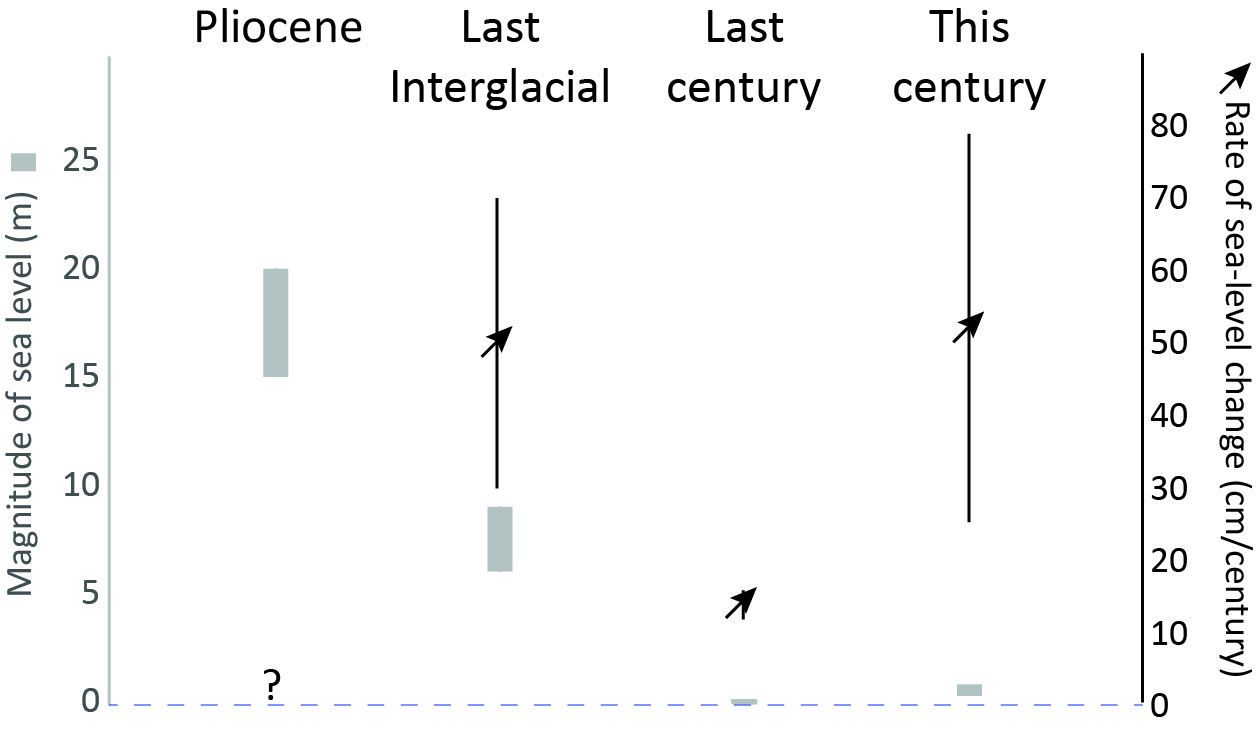- Home
- Publications
- PAGES Magazine
- Editorial: A Decade of PALSEA: Advances and Future Aims
Editorial: A decade of PALSEA: Advances and future aims
Barlow NLM, Milne GA & Shakun JD
Past Global Changes Magazine
27(1)
3
2019
Natasha L.M. Barlow1, G.A. Milne2 and J.D. Shakun3
In 2019, the PAGES and INQUA-CMP (inqua.org/commissions/cmp) working group PALeo constraints on SEA level rise (PALSEA) entered its third phase. Established in 2008 by Mark Siddall and colleagues (Siddall et al. 2009), the second phase of PALSEA (PALSEA2, 2013-2017) was led by Anders Carlson, Andrea Dutton, Antony Long and Glenn Milne. The group continued the successful approach of bringing together observational and modeling scientists focusing on ice-sheet, climate and sea-level change to better define constraints on ice-sheet-driven paleo sea-level rise and apply this knowledge to inform projections of future change. Increased dialogue between these, and broader, communities over the past 10 years of PALSEA have resulted in over 100 peer-reviewed publications tackling societally important questions as to the drivers of ice-sheet and sea-level change. The consequences have been far-reaching, with a key indicator being the significant paleo sea-level and ice-sheet components included in the IPCC AR5 report (Church et al. 2013; Masson-Delmotte et al. 2013), and several members of the PALSEA community currently working as authors of the IPCC AR6 report.
One standout contribution of the PALSEA working group has been the considerable progress made by the observational community to agree on best practice for methods to reconstruct the elevation of former sea levels (Khan et al. p. 10). This has resulted in the production of a standardized sea-level database protocol (Düsterhus et al. 2016; Khan et al. p. 10) and a growing number of high-quality regional and global databases for different time periods (Miller et al. p. 4; Dutton and Barlow, p. 6; Barnett et al. p. 8; Khan et al. p. 10) that provide the foundation for empirical and process-based modeling studies which aim to identify the underlying driving mechanisms across a range of temporal and spatial scales.
Research stimulated by PALSEA has identified processes that complicate estimates of global mean sea level (GMSL), and thus ice volume, from a geographically distributed set of local releative sea level (RSL) reconstructions. This has led to ongoing efforts to improve our understanding and ability to more accurately model processes such as glacial isostatic adjustment (Milne et al. p. 16), mantle dynamic topography (Austermann and Forte, p. 18), sediment flux and associated loading (Ferrier et al. p. 24), and overprinting records of extreme storm or wave events (Engelhart et al. p. 26). As these models improve, so too will estimates of global ice volume during past warm periods, providing a target and stimulus for the data and modeling communities to determine the minimum extent of the Greenland and Antarctic ice sheets and thus the climate drivers of sea-level rise during key intervals of Earth’s history (Carlson and Larsen. p. 12; Sime et al. p. 14; de Boer et al. p. 20; Otto-Bliesner et al. p. 22).
Late Holocene RSL research (Barnett et al. p. 8) has shown that an ability to constrain rates of sea-level change can provide important insights into drivers, synchronicity, and feedbacks in the coupled Earth system. However, prior to the radiocarbon dating window (ca. >40 kyr BP), establishing rates of both ice-sheet and sea-level change continues to be a challenge (Miller et al. p. 4; Dutton and Barlow, p. 6). While community efforts to better quantify GMSL have been successful, constraining rates of change during past warm periods remains an elusive target (Fig. 1), but a critical one to more effectively use paleo observations in future projections (Horton et al. p. 28). The spatial aspect of the problem has also been brought to the fore though PALSEA activities. Sea-level change is not globally uniform and so there is now a clear shift towards developing and understanding regional sea-level changes and relating these to GMSL.
The new phase of PALSEA, led by researchers who have benefited from the PALSEA network as early-career scientists (Jacqueline Austermann, Natasha Barlow, Alessio Rovere and Jeremy Shakun), seeks to build on past success and focus efforts on moving towards some of the outstanding goals outlined above. As the contemporary system exhibits accelerated and potentially irreversible changes (e.g. Shepherd et al. 2018), the relevance of the paleo record, which contains information on such responses in the past, becomes even more critical (Horton et al. p. 28). This Past Global Changes Magazine brings together contributions that summarize the state-of-the-science following the last decade of investigation and collaboration, as well as provide a stimulus into critical areas of research for PALSEA and the wider community.
affiliations
1School of Earth and Environment, University of Leeds, UK
2Department of Earth and Environmental Sciences, University of Ottawa, Canada
3Department of Earth and Environmental Sciences, Boston College, USA
contact
Natasha Barlow: N.L.M.Barlow leeds.ac.uk
leeds.ac.uk
references
Düsterhus A et al. (2016) Clim Past 12: 911-921
Dutton A et al. (2015) Science 349: aaa4019
Kopp RE et al. (2013) Geophys J Int 193: 711-716
Kopp RE et al. (2016) Proc Natl Acad Sci 113: E1434-E1441

